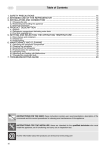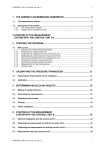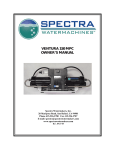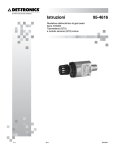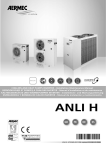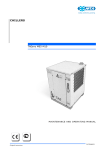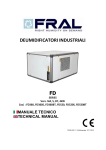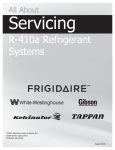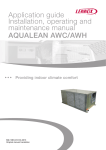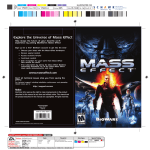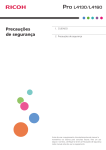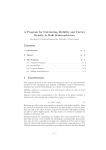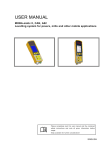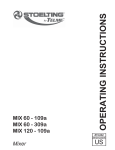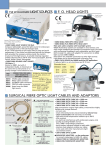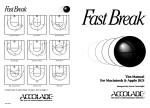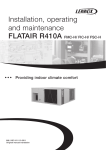Download Technical Manual
Transcript
USER INSTRUCTIONS & MAINTENANCE AIR COOLED CHILLER & HEAT PUMP CFA - CHA EN R14.13.M USER INSTRUCTIONS AND MAINTENANCE 2 EN R14.13.M USER INSTRUCTIONS AND MAINTENANCE GENERAL TABLE OF CONTENTS 1. CE model plate Pag. 04 2. Safety notes Pag. 05 3. Symbols on the unit Pag. 06 Pag. 08 4. User and maintenance manual 3 EN R14.13.M USER INSTRUCTIONS AND MAINTENANCE 1. CE MODEL PLATE 4 EN R14.13.M USER INSTRUCTIONS AND MAINTENANCE 2. SAFETY NOTES Note sulla sicurezza per l’utilizzo della macchina Read this Manual carefully before using the unit! Keep the manual safe and ready for consultation for all future requirements! ALWAYS PROVIDE CUT-OUTS SO THAT THE POWER FEEDING LINE OF THE UNIT CAN BE DISCONNECTED FROM THE ELECTRICAL MAINS SUPPLY, EVEN IN THE PRESENCE OF A UNIT ON/OFF CONTROL TRANSMITTED FROM THE CUSTOMER’S REMOTE STATION. ALWAYS DISCONNECT THE ELECTRICAL POWER SUPPLY BEFORE CARRYING OUT MAINTENANCE!For details, refer to the unit’s wiring diagrams. (1) Keep the unit in a VERTICAL POSITION during loading and unloading procedures and check that installation surface is perfectly HORIZONTAL with a spirit level; (2) Install the unit in a place that allows proper ventilation of the condensers! Do not install the unit indoors or in a poorly ventilated place! (3) Do not inspect the unit electrical panel with wet or moist hands (risk of electric shock); (4) When the unit is running do not place objects on the top (object may fall with resulting damage to the unit and injury to operators); (5) Maintenance must be performed ONLY by skilled personnel. When the covers of the electrical panels or external condenser/fans compartment are opened by a maintenance technician, other maintenance personnel or other persons in the area must be notified of the potential hazard my means of specific warning notices! (6) Do not use tools or objects to touch the fan impeller blades (risk of injury to persons or damage to property or the unit). (7) THE UNIT IS NOT SUITABLE FOR USE IN EXPLOSIVE ATMOSPHERES! (8) The units are designed and approved for operation in industrial and residential environments. For more information, consult the Engineering Department. (9) The Manufacturer provides one year of warranty from the date of shipment and the warranty will be held valid only if no repairs or modifications of the unit have been carried out by personnel not authorised by the Manufacturer. To avoid problems, possible accidents, or injury to persons, consult our technical personnel for authorisations for possible alterations or refittings, repairs, removal of components or disassembly of the entire unit. 10) THE UNIT CONTAINS FLUORINATED GASES (R410A) THE GREENHOUSE EFFECT OF WHICH IS REGULATED BY THE PROVISIONS OF THE KYOTO PROTOCOL! (REGULATION 842/2006/EC) 5 EN R14.13.M USER INSTRUCTIONS AND MAINTENANCE 3. SYMBOLS ON THE UNIT BODY # 1 2 3 4 5 GRAFICA SYMBOL SYMBOL SÍMBOLO DESSIN FUNZIONE FUNCTION FUNKTION FUNCIÓN FONCTION Ingresso cavo elettrico Electric cable inlet Eingang Stromkabel Entrada cable eléctrico Entrée câble électrique PERICOLO, PRESTARE ATTENZIONE! DANGER, PAY ATTENTION! GEFAHR, VORSICHT! ¡PELIGRO, PRESTAR ATENCIÓN! DANGER, FAIRE ATTENTION ! Pericolo ALTA TENSIONE sui componenenti! HIGH VOLTAGE on components! Gefahr HOCHSPANNUNG an den Bauteilen! ¡Peligro ALTA TENSIÓN en los componentes! Danger HAUTE TENSION sur les composants ! Senso di rotazione Rotation direction Drehrichtung Sentido de rotación Sens de rotation Sollevamento (impiego dei golfari) Hoisting point (use eyebolts) Heben (Hebeösen verwenden) Elevación (uso de los cáncamos) Levage (emploi des anneaux) IMPORTANT WARNINGS The indication IMPORTANT WARNINGS is used to focus attention on actions or hazards that could damage the unit or its equipment ENVIRONMENTAL PROTECTION The indication Environmental Protection supplies instructions for use of the machine. 6 EN R14.13.M USER INSTRUCTIONS AND MAINTENANCE 4. USER AND MAINTENANCE MANUAL CONTENTS OF THE MANUAL CONTENTS OF THE MANUAL .................................................................................. 07 1. Introduction to the range ............................................................................................ 09 1.1 Description of the units ..................................................................................... 09 1.2 Identification of the units .................................................................................. 11 1.3 Operating conditions and limits ....................................................................... 12 1.4 Unit performance .............................................................................................. 14 1.4.1 Cooling duty and electrical power consumption values ............................................. 14 1.4.2 Heating duty and electrical power consumption values ............................................. 15 1.4.3 Sound pressure level .......................................................................................... 16 2. Installation requirements ........................................................................................... 17 2.1 Lifting abd transport ......................................................................................... 18 2.2 Installation and positioning............................................................................... 20 2.3 Hydraulic connections ...................................................................................... 22 2.3.1 Water filling ..................................................................................................... 22 2.3.2 Water drain ...................................................................................................... 22 2.4 Installation of the electrical parts ...................................................................... 23 3. Commissioning and running the unit ......................................................................... 25 3.1 Start-up and operation notes ............................................................................ 25 3.2 Description of the electrical panel and controller ............................................ 26 3.2.1 Operation and regulation .................................................................................... 26 3.2.2 Unit ON/OFF ................................................................................................... 26 3.2.3 User display ..................................................................................................... 27 3.2.4 Parameters programming and saving procedure....................................................... 27 3.2.5 Programming the Set-Point ................................................................................. 28 3.2.6 Probes reading .................................................................................................. 29 3.2.7 Alarm display ................................................................................................... 30 3.3 Operating features ............................................................................................ 32 3.3.1 Display temperature........................................................................................... 32 3.3.2 Set-Point cooling mode (Chiller & Heat Pump) ....................................................... 32 3.3.3 Set-Point heating mode (Heat Pump) .................................................................... 32 3.3.4 Compressor start time lag ................................................................................... 32 7 EN R14.13.M USER INSTRUCTIONS AND MAINTENANCE 3.3.5 Antifreeze function ............................................................................................ 32 3.3.6 Antifreeze function with support heaters (Option) .................................................. 33 3.3.7 No-flow protection .......................................................................................... 33 3.3.8 Regulation and control of the pump ..................................................................... 33 3.3.9 Fan(s) ON/OFF ............................................................................................... 34 3.3.10 Fan(s) speed control (Option)............................................................................. 34 3.3.11 Set point compensation (Option) ......................................................................... 35 3.3.12 Water filling kit (Option) ................................................................................... 35 3.3.13 Water strainer (Option) ..................................................................................... 36 3.3.15 Spurge valve (Option) ...................................................................................... 36 3.3.16 Double set point (Option) .................................................................................. 37 3.3.17 Phase sequence control (Option) ......................................................................... 37 3.3.18 Secondary pump control (Option) ....................................................................... 37 3.4 Operative settings of the controller .................................................................. 38 3.4.1 Menu structure.................................................................................................. 38 3.4.1 Parameters ....................................................................................................... 39 3.5 Trouble shooting .............................................................................................. 45 4. Maintenance ............................................................................................................... 48 4.1 Periodic clearing of the unit ............................................................................. 49 4.1.1 Periodic inspection and cleaning of the coils ........................................................... 49 4.1.2 Inspection and washing og the water exchanger ...................................................... 49 4.2 Compressor damage ......................................................................................... 49 4.2.1 Lubrication and removal of the oil ........................................................................ 50 4.3 Procedures in the event prolonged inactivity of installed units ........................ 50 4.3.1 Preliminary check (Pre Start-up) .......................................................................... 51 5. Warranty .................................................................................................................... 52 6. Scrapping/Disposal of the unit at the end of its working life .................................... 53 6.1 Disposal of fluids .............................................................................................. 53 6.1.1 Emptying of refrigerant ...................................................................................... 53 6.1.2 Compressor lubricating oil .................................................................................. 53 6.2 Scrapping of the unit ......................................................................................... 54 APPENDIX I / R410a Technical data sheet ................................................................... 55 8 EN R14.13.M USER INSTRUCTIONS AND MAINTENANCE 1. Introduction to the range 1.1 Description of the units The series constitutes a range of air-cooled water chillers designed to meet the requirements of low and medium capacity process cooling and air conditioning plants, operating with R410A, a non-flammable and non-toxic high efficiency refrigerant for optimal energy saving in operation of the unit. The entire range is composed of a wide range of models characterised by the use of scroll compressors, with one or two separate refrigerant circuits, and plate evaporators in brazed AISI stainless steel. The fans installed are of the axial low-noise type. The equipment can consist of a pump, pump with storage tank, dual pump, or dual pump with storage tank. The pump and storage tank assembly is designated “hydronic kit”. Control of the chillers is provided by an electronic microprocessor controller. The refrigerant and hydraulic circuits comply with the PED directive. Special or LT (low water temperature) units are available on different type of refrigerant gas, compressors and evaporators depending on the application. Compressors The standard compressors are of the hermetic scroll type with orbital scrolls. The rotating scroll is driven by a two-pole motor cooled by the refrigerant on the suction line. All the compressors are complete with a crankcase heater to prevent mixing of oil with the refrigerant during stoppages, electronic thermal protection (if part of the equipment) and thermal overload protection. All models in the range with multiple compressors are provided with the unloading function. When a high condensing temperature is reached (as established by a pressure switch) due to abnormally high ambient temperature, one compressor stops on each circuit. This results in oversizing of the condensing coil surface area and dropping of the condensing temperature. Output in these conditions is slightly higher than 50% of total output but it becomes unnecessary to stop the unit so that cooling can continue throughout the critical period. The compressors are filled with polyester oil (POE), which is suitable for use in conjunction with R410A. Special or LT (low water temperature) units are available on different type of refrigerant gas, compressors and evaporators depending on the application. Water-refrigerant plate evaporator The evaporators are composed of AISI 316 stainless steel brazed plate exchangers. The exchangers are clad externally with an anticondensation mat made of closed cell expanded foam. The exchanger is protected by a series of temperature probes installed on the refrigerant discharge having an anti-freeze function, and by a pressure switch monitoring the pressure differential between refrigerant suction and discharge sides. Special or LT (low water temperature) are available on different type of evaporator depending on the application 9 EN R14.13.M USER INSTRUCTIONS AND MAINTENANCE Air-cooled condenser The air-cooled condenser is composed of a finned core coil made with copper tubes and high-efficiency corrugated aluminium fins adequately spaced in such a way as to ensure optimal heat exchange efficiency. The copper tubes are of sufficient diameter and wall thickness to withstand the highest R410A resign pressures. Options: • Metal mesh filters • Prepaited condensing coils • Electrophoresis on the condensing coils Axial Fans Axial fans with IP 54 protection rating, external rotor, with moulded blades made of fibreglass-reinforced plastic with a die cast aluminium core. The fans are accommodated in dynamically profiled external ports complete with a safety mesh protecting the exterior side. Electrical cabinet for power and control circuits Electrical power and control cabinet, made in compliance with EN 60204-1/IEC 204-1 (Safety of Machinery), complete with: - control circuit transformer; - main door-lock circuit breaker; - thermal-magnetic cut-outs or fuses protecting compressors, fans and pumps - contractors controlling compressors, fans and pumps; - terminals for common alarms block; - terminals for remote On/Off input; - control circuit terminal boards; - exterior quality electrical cabinet with single door and weather seals; - electronic controller; - control circuit numbered cables; - 400/3/50Hz power supply; 230 Vac and 24 Vac control circuits for the electronic controller. Options: • phase sequence monitoring; • electrical cabinet fan; • electrical cabinet anticondensation heater; • remote keypad kit. Microprocessor controller All units series units are equipped with a microprocessor controller capable of managing the following functions: -water temperature control in the traditional method with a probe on the system return line (especially suitable for applications in which an inertia storage tank is installed); -fans ON-OFF control; -freeze protection; -automatic compressors start sequence rotation; -compressor time intervals; -alarms signalling and reset; -presentation on the display of the programmed set-points and the values read by the probes. 10 EN R14.13.M USER INSTRUCTIONS AND MAINTENANCE 1.2 Identification of the units CHILLER / HEAT PUMP CFA CHA 12 1 2 S P-B ST 3 4 5 20 6 1 7 MAP3 8 1 – MODEL CF – Water chiller CH – Heat pump 2 – CONDENSING MODE A = Air cooled unit W= Water cooled unit 3 – COMPRESSORS TYPE S = Hermetic scroll V = Semi-hermetic double screw P = Alternative piston 4 – EVAPORATOR-CONDENSER TYPE P-B = Plate-Finned coils P-P = Plate-Plate F-B = Shell&tube-Finned coils F-F = Shell&tube-shell&tube 5 – VERSION ST= Standard unit (axial fans CFA/CHA models - water condenser CFW/CHW models) MC = Condensing unit (remote evaporator) ME = Condenser less unit (remote condenser) FC = Free-cooling unit (axial fans) CV = Unit with centrifugal fans LT = Unit suitable for low water temperature (Brine chiller) SP = Special unit 6 – COOLING CAPACITY Numerical value denoting the cooping capacity in kW in nominal conditions (water 12/7 °C and ambient 35 °C) 7 – NUMBER OF COMPRESSORS 1 = one compressor 2 = two compressors 4 = for compressors 8 – HYDRAULIC MODULE MB = Basic unit, without hydraulic module MP2 (MDP2) = Unit with P2 pump 2 nominal bar pressure (double P2) MP3 (MDP3) = Unit with P3 pump 3 nominal bar pressure (double P3) MP5 (MDP5) = Unit with P5 pump 3 nominal bar pressure r (double P5) MAP2 (MADP2) = Unit with storage tank and P2 pump 2 nominal bar pressure (double P2) MAP3 (MADP3) = Unit with storage tank and P3 pump 2 nominal bar pressure (double P3) MAP5 (MADP5) = Unit with storage tank and P5 pump 5 nominal bar pressure (double P5) 11 EN R14.13.M USER INSTRUCTIONS AND MAINTENANCE 1.3 Operating conditions and limits Operating limits in Cooling mode CHILLER Water inlet temperature Water outlet temperature Temperature gradient Ambient air temperature °C °C °C °C MIN 5/-5(*) 0/-9(*) 4 -5 / -20 (**) MAX 25 15 8 (***) (*) With Double set-point option If water temperature is below to +5 °C, i’s complulsory to use glycol on the right percentage, as per the table in the next page (**) First value refers to standard unit. Second value refers to unit with fans electronic control, antifreeze heater on pump and storage tank (when present). (***) Value depends on size of chiller and operating conditions. Operating limits in Heating mode HEAT PUMP Water inlet temperature Water outlet temperature Temperature gradient Ambient air temperature °C °C °C °C MIN MAX 25 45 30 50 (***) / 40 (****) 4 8 -5 20 (***) Max hot water outlet temperature with minimum ambient air temperature of +5 °C (****) Max hot water outlet temperature with minimum ambient air temperature of -5 °C In the presence of a risk of freezing of the fluid medium in the hydraulic circuit antifreeze mixtures are required; the following are guideline values of the freezing point for mixtures of water and ethylene glycol, withy glycol percentages expressed in weight. To avoid pump damage in the event of glycol percentages above 25%, consult the Sales Department. The use of this type of mixture causes slight alterations in some of the thermodynamic parameters of the chillers. The new values can be established by multiplying the value of the required parameter in nominal operating conditions by the appropriate coefficients shown in the following table: 12 EN R14.13.M USER INSTRUCTIONS AND MAINTENANCE % GLYCOL by weight 10 20 30 40 50 Freezing temperature (°C) Cooling capacity correction factor Absorbed power correction factor Mixture flow rate correction factor Pressure drops correction factor -3,7 0,99 0,99 1,02 1,083 -8,7 0,98 0,98 1,05 1,165 -15,3 0,97 0,98 1.07 1,248 -23,5 0,96 0,97 1,11 1,33 -35,6 0,93 0,95 1,13 1,413 WARNING! WITHOUT GLYCOL IN THE SYSTEM: IMPORTANT! If the unit is not used in the winter the water in the circuit may freeze IMPORTANT! The use of mixtures of water with glycol affects performance characteristics of the unit 13 EN R14.13.M USER INSTRUCTIONS AND MAINTENANCE 1.4 Unit performance 1.4.1 Cooling duty and electrical power consumption values The chiller performance depend mainly from the water flow rate, water temperature and ambient temperature. These values are defined during the commercial offer and it must refer to them. Performance values of the models in the range of chillers are shown below referred to water inlet/outlet temperature of 12/7 °C and ambient temperature of 35 °C CFA 2.1 3.1 4.1 5.1 6.1 8.1 Cooling capacity kW 1,9 2,7 3,9 5,1 6,1 7,8 Adsorbed compressor(s) power kW 0,7 0,9 1,4 1,9 2,3 2,8 CFA 10.1 13.1 15.1 20.1 26.1 30.1 Cooling capacity kW 9,2 13,1 15,2 19,7 26,1 30,2 Adsorbed compressor(s) power kW 3,2 4,5 5,3 6,4 8,8 9,6 CFA 34.1 39.1 45.2 53.2 59.2 66.2 Cooling capacity kW 33,3 39,3 43,3 52,7 58,3 66,1 Adsorbed compressor(s) power kW 10,7 12,8 15,4 16,5 19,4 21,6 CFA 75.2 90.2 98.2 110.2 126.2 145.2 Cooling capacity kW 75,0 89,1 97,4 110 125,7 144,2 Adsorbed compressor(s) power kW 26,5 28,7 33,5 37,8 40,8 46,5 CFA 158.2 180.4 195.4 220.4 250.4 290.4 Cooling capacity kW 157,6 176,0 199,8 220 249,3 288,4 Adsorbed compressor(s) power kW 54,5 58,7 64,7 75,7 82,3 92,9 CFA 315.4 376.4 412.4 Cooling capacity kW 315,2 375,5 412,0 Adsorbed compressor(s) power kW 109,0 116,0 135,2 Model Model Model Model Model Model 14 EN R14.13.M USER INSTRUCTIONS AND MAINTENANCE 1.4.2 Heating duty and electrical power consumption values The heat pump performance depend mainly from the water flow rate, water temperature and ambient temperature. These values are defined during the commercial offer and it must refer to them. Performance values of the models in the range of heat pumps are shown below referred to water inlet/outlet temperature of 40/45 °C and ambient temperature of 7 °C (UR 87%) CHA 2.1 3.1 4.1 5.1 6.1 8.1 Heating capacity kW NA NA NA 5,6 6,9 8,8 Adsorbed compressor(s) power kW NA NA NA 1,9 2,2 2,7 CHA 10.1 13.1 15.1 20.1 26.1 30.1 Heating capacity kW 9,9 14,5 17,1 21,6 29 32,7 Adsorbed compressor(s) power kW 3 4,5 5,1 6,3 8,3 9,4 CHA 34.1 39.1 45.2 53.2 59.2 66.2 Heating capacity kW 39,7 43,5 49,3 59,8 66,7 74,5 Adsorbed compressor(s) power kW 10,3 12,1 14,3 16,3 18,3 20,2 CHA 75.2 90.2 98.2 110.2 126.2 145.2 Heating capacity kW 86 101 111 125,7 140,4 163 Adsorbed compressor(s) power kW 23,7 27,2 30,7 34,7 39 44,3 CHA 158.2 180.4 195.4 220.4 250.4 290.4 Heating capacity kW 178,4 198,8 225 251,3 280,8 325,8 Adsorbed compressor(s) power kW 49,5 55,1 62,1 69,5 77,6 88,6 CHA 315.4 376.4 412.4 Heating capacity kW 356,8 NA NA Adsorbed compressor(s) power kW 99,2 NA NA Model Model Model Model Model Model 15 EN R14.13.M USER INSTRUCTIONS AND MAINTENANCE 1.4.3 Sound pressure level The following table gives the noise data in Sound Pressure Lp(A) at 10 meters from the condensing coil and 1 metre height above ground in free field conditions (direction factor Q=2). The Sound Pressure level refers to the machine std layout with the compressors compartment insulated with sound absorbing matting. Model Sound pressure (10 m) Model Sound pressure (10 m) Model Sound pressure (10 m) Model Sound pressure (10 m) Model Sound pressure (10 m) Model Sound pressure (10 m) CFA/CHA 2.1 3.1 4.1 5.1 6.1 8.1 dB(A) 42* 42* 42* 43 43 46 CFA/CHA 10.1 13.1 15.1 20.1 26.1 30.1 dB(A) 47 47 47 47 48 48 CFA/CHA 34.1 39.1 45.2 53.2 59.2 66.2 dB(A) 48 49 49 47 48 49 CFA/CHA 75.2 90.2 98.2 110.2 126.2 145.2 dB(A) 49 52 54 56 57 57 CFA/CHA 158.2 180.4 195.4 220.4 250.4 290.4 dB(A) 57 58 58 59 60 60 CFA/CHA 315.4 376.4 412.4 dB(A) 61 63* 63* * Values referred to the chiller execution 16 EN R14.13.M USER INSTRUCTIONS AND MAINTENANCE 2. Installation Requirements 2.1 Lifting and transport Before lifting the unit refer to the following WEIGHTS table, wherein values are calculated without the hydraulic unit: 17 EN R14.13.M USER INSTRUCTIONS AND MAINTENANCE Model 2.1 3.1 4.1 5.1 6.1 8.1 Weight (basic unit*) CFA kg 150 160 165 180 190 200 Weight (basic unit*) CHA kg ND ND ND 200 210 220 10.1 13.1 15.1 20.1 26.1 30.1 Model Weight (basic unit*) CFA kg 230 240 255 350 365 380 Weight (basic unit*) CHA kg 250 265 280 380 400 415 34.1 39.1 45.2 53.2 59.2 66.2 Model Weight (basic unit*) CFA kg 460 480 560 620 635 655 Weight (basic unit*) CHA kg 500 530 620 670 685 720 75.2 90.2 98.2 110.2 126.2 145.2 Model Weight (basic unit*) CFA kg 680 870 950 1020 1100 1160 Weight (basic unit*) CHA kg 740 940 1030 1100 1190 1255 158.2 180.4 195.4 220.4 250.4 290.4 Model Weight (basic unit*) CFA kg 1180 1360 1570 1630 2050 2100 Weight (basic unit*) CHA kg 1280 1600 1780 1880 2250 2290 315.4 376.4 412.4 Model Weight (basic unit*) CFA kg 2210 2630 2680 Weight (basic unit*) CHA kg 2450 ND ND * Basic unit: provided with plate evaporator, differntial pressure switch, 4-way valve (only for heat pumps) 18 EN R14.13.M USER INSTRUCTIONS AND MAINTENANCE DANGER! The unit must be handled with care to avoid damage to the external structure and the internal mechanical end electrical components. Also make sure that there are no obstacles or persons along the route, to avoid the risk of collision, crushing or overturning of the lifting and handling vehicle. The unit can be handled and/or lifted exclusively using the specific lifting attachments incorporated in the frame. Lifting of the unit is possible by means of textile webbing inserted in the channels in the base frame, or by means of the forks of a suitable lift truck. Once the unit has been installed remove the protective film from the panelling and the shrink wrap plastic. ENVIRONMENTAL PROTECTION Dispose of the packing materials in compliance with national legislation and local bylaws in your country. DANGER! Keep packaging materials out of reach of children. 19 EN R14.13.M USER INSTRUCTIONS AND MAINTENANCE 2.2 Installation and positioning (1) The unit must be installed in a site with good air quality without a corrosive or inflammable or exceptionally dusty atmosphere. THE UNIT IS NOT SUITABLE FOR USE IN EXPLOSIVE ATMOSPHERES! (2) The unit must be installed in a site in which ventilation is sufficient and the heat release by the unit can be easily dispersed to the exterior. Considering that the chiller disperses heat to the exterior when it is running, if the place of installation is confined or lacks sufficient fresh air, the room temperature will rise progressively and the hot air, which will recirculate over the condenser, will cause rapid degradation of the performance to the point at which the unit shuts down due to high pressure. IMPORTANT ! The unit must be sited taking account of the minimum recommended clearances, taking account of the position of the condensing coils and accessibility of the hydraulic and electrical connections. An installation without the recommended clearances will cause poor operation of the unit with an increase in power consumption and a reduction in cooling capacity due to an increase in the condensing pressure. The area above the unit must be completely free of obstacles in such a way as to guarantee unimpeded air flow from the condensing fans. If the unit is surrounded by walls, the minimum clearances shown are still valid as long as at least the two adjoining walls closest to the unit are no higher than the total height of the unit. Greater spaces than the spaces indicated must be provided to allow handling of any components to be replaced. 20 EN R14.13.M USER INSTRUCTIONS AND MAINTENANCE MODEL Installation clearances L1 L2 L3 L4 CFA/CHA mm mm mm mm MODEL Installation clearances L1 L2 L3 L4 2.1 - 45.2 53.2 - 75.2 90.2-110.2 1000 1000 800 1000 1000 1000 800 1000 CFA/CHA mm mm mm mm 1000 1200 800 1000 126.2-158.2 180.4-220.4 1000 1200 800 1000 1000 1200 800 1000 250.4-315.4 376.4-412.4 1000 1200 800 1200 1000 1200 800 1200 (3) To ensure a sufficient air flow the condenser fins must NEVER be obstructed or excessively fouled; (4) Free air circulation around the electrical cabinet must be guaranteed. 21 EN R14.13.M USER INSTRUCTIONS AND MAINTENANCE 2.3 Hydraulic connections All hydraulic connections are at care of the customer. Connect the unit to the water pipes observing the direction as indicated in the cooling circuit. Check the yellow labels on the inlet/outlet unit. Provide inlet/outlet valves in order to do an easy maintenance without draining the unit. It’s mandatory to install an 0.5-0.8 mm mesh filter on the chiller water inlet. It can be supply as an option of the unit. 2.3.1 Water filling Basic unit: provided with evaporator and pressure differential (or flow switch). The water filling can be outside the unit (at customer’s care) or inside the unit by a filling kit (suitable as an option of the unit see the paragrafe “Water filling kit”). Use the air vent (check the position in the cooling circuit) to help the venting procedure. Unit with pump (double pumps): provided with evaporator, differential pressure switch (or flow switch) and pump (double pumps). The water filling can be outside the unit (at customer’s care) or inside the unit by a filling kit (suitable as an option of the unit see the paragrafe 3.3.9 “Water filling kit”). Use the air vent (check the position in the cooling circuit) to help the venting procedure. Unit with pump (double pumps) and storage tank: provided with evaporator, differential pressure switch (or flow switch), pump (double pumps) and storage tank. The water filling can be outside the unit (at customer’s care) or inside the unit by a filling kit (suitable as an option of the unit see the paragrafe “Water filling kit”). Use the air vent (check the position in the cooling circuit) to help the venting procedure. The maximum admissible internal hydraulic pressure is 6 bar. 2.3.2 Water drain Basic unit: provided with evaporator and differential pressure or flow switch. The drain valve is placed under the evaporator. Unit with pump (double pump): provided with evaporator, differential pressure or flow switch and pump (double pump). The drain valves are placed under the evaporator and the pump. Unit with pump (double pump) and storage tank: provided with evaporator, differential pressure or flow switch, pump (double pump) and storage tank. The drain valves are placed under the evaporator, the pump, and the storage tank or outside the unit (purge valve on the units with filling kit). WARNING! For the whole water drain of the unit is necessary to use all of the valves provided on evaporator / storage tank / pump. The partial water drain of the unit may result in the risk of freezing and subsequent collapse of some of its parts (see paragraph 1.3 "Terms of Use and Limits"). Check on the unit yellow label representatives drainage points. 22 EN R14.13.M USER INSTRUCTIONS AND MAINTENANCE 2.4 Installation of the electrical parts The units are completely wired in the factory. The only cable required is the connection to the electrical mains supply, the connection of the flow switch (optional) and the remote On/Off switch (ON-OFF jumpered by default). All operations described above must be carried out by qualified personnel in compliance with statutory legislation. For all electrical work refer to the wiring diagrams. General warning or precautions to be strictly observed. Serious hazard. Electric shock hazard. THE UNIT ELECTRICAL HOOK-UP MUST BE CARRIED OUT BY A LICENSED ELECTRICIAN WITH THE NECESSARY PROFESSIONAL SKILLS AND IN COMPLIANCE WITH STATUTORY REGULATIONS IN THE COUNTRY OF INSTALLATION ! IMPORTANT ! FOR INSTALLATION REFER TO THE UNIT WIRING DIAGRAMS SUPPLIED ON BOARD THE UNIT TOGETHER WITH THIS MANUAL, AND TO THE DATA ON THE CE RATING PLATE (1) The unit must be connected to the power supply only when the installation work (mechanical, hydraulic and electrical) has been completed. (2) The electronic control board is located in the chiller electrical cabinet. Only qualified technicians must open the unit to perform work on it. To hook up the unit to the mains electrical panel, for power feeding and for the signals input/output, always refer to the wiring diagram. (3) Comply with the connection specifications for the phase and protective earth conductors. There must be a specific protection against short circuits and ground faults upline from the power feeding line, capable of disconnecting the plant from all other users. (4) Install suitable protection on the unit power feeding line in compliance with the regulations in force in the country in which the unit is installed. (5) For the electrical connections use cables that comply with the statutory electrical regulations in force in the country of installation (6) After installation, check that the mains power values are within a tolerance of 23 EN R14.13.M USER INSTRUCTIONS AND MAINTENANCE ±10% of the nominal machine input voltage (unless otherwise specified on the electrical wiring diagram) with a maximum phase-to-phase imbalance of 3%. If these parameters are not present, contact your local electricity company. (7) No external thermostat can be used to connect/disconnect the unit’s power feeding line, or malfunctions and poor performance of the unit will result. (8) Keep the power lines separate from the signal cables; signal cables must be shielded and connected to a voltage-free PE point at just one end of the shield. (9) It is mandatory to make an efficient protective earth connection. The manufacture cannot be held liable for any damage caused by the omitted or inefficient connection of the unit to the earth system. 24 EN R14.13.M USER INSTRUCTIONS AND MAINTENANCE 3. Commissioning and running the unit 3.1 Start-up and operation notes Before starting up the unit check that the water circuit pipes have been correctly connected to the evaporator and that the electrical panels and condenser compartment doors are properly closed. At this point the chiller can be started. Pay attention to moving parts if the panels or covers are raised or have been removed from the unit! Access to the unit is permitted only to qualified technical personnel. 25 EN R14.13.M USER INSTRUCTIONS AND MAINTENANCE 3.2 Description of the electrical panel and controller The electrical panel is located inside the unit at the top of the technical compartment that houses the various refrigerant circuit components. To gain access to the electrical panel open the front panel of the unit after setting the door lock breaker switch to 0 (OFF). 3.2.1 Operation and regulation The electrical cabinet is equipped with a main disconnect switch with door-lock device. Feeding of the 230Vac auxiliary circuits and the 24Vac control circuits is obtained internally from the three-phase power input. Adjustments can be carried out by means of a compact electronic controlled, of the size of a normal thermostat, which provides complete management of the chiller. 3.2.2 Unit ON/OFF Turn ON the main switch COOLING MODE (CHILLER & HEAT PUMP) - To start the unit hold down the for 5 seconds the key . The pump operating mode LEDs will light Depending on the return temperature from the installation one or both compressors may be started. To stop the unit hold down for 5 seconds the key . HEATING MODE (ONLY HEAT PUMP) - To start the unit hold down the for 5 seconds the key The pump operating mode LEDs will light - Depending on the return temperature from the installation one or both compressors may be started. - To stop the unit hold down for 5 seconds the key 26 . . EN R14.13.M USER INSTRUCTIONS AND MAINTENANCE 3.2.3 User display MEANING SYMBOL COLOUR 1;2 3;4 A B C D E F G H amber amber amber amber amber amber amber red amber amber WITH LED ON Compressor 1 and/or 2 running Compressor 3 and/or 4 running At least one compressor running Pump running Condenser fan running Defrost on Crankcase heater on Active alarm Heat pump mode Chiller mode REFERENCE REFRIGERANT CIRCUIT 1 2 1/2 1/2 1/2 1/2 1/2 1/2 1/2 1/2 WITH LED FLASHING Start request Start request Start request Defrost request Heat pump mode request Chiller mode request 3.2.4 Parameters programming and saving procedure - Press and for 5 s; The hot and cold symbol and the value “00” will appear; - Use and to set the password and confirm with - Use and to select the parameters menu S-P and confirm with - Use and to select the parameters group and confirm with - Use and to select the parameter and confirm with - Once the parameter has been edited press changes; - Press ; to confirm or ; ; ; to cancel your to restore the previous menu; Notes: - Parameters edited without confirmation by pressing will simply revert to the previous value; If no keys are pressed for 60 s, the controller will quit the parameters editing menu due to time-out and the changes that have been made will be cancelled. 27 EN R14.13.M USER INSTRUCTIONS AND MAINTENANCE 3.2.5 Programming the Set-point COOLING MODE (CHILLER) To change the set point, proceed as follows: - Press - Use the for 5 sec to access the main parameters window. or key to scroll to the submenu. - Press to access submenu and use the through the parameters accessible from said menu. - To change the Set-point, parameter - After displaying the value, use the - Thereafter, press your changes. - Finally, press menu. or key to scroll , press or keys to change it. to quit without saving your changes or press to save to return to the higher level and/or exit the configuration HEATING MODE (HEAT PUMP) To change the set point, proceed as follows: - Press - Use the for 5 sec to access the main parameters window. or key to scroll to the submenu. - Press to access submenu and use the through the parameters accessible from said menu. or key to scroll - To change the Set-point, parameter 03, press - After displaying the value, use the - Thereafter, press your changes. - Finally, press menu. or keys to change it. to quit without saving your changes or press to save to return to the higher level and/or exit the configuration 28 EN R14.13.M USER INSTRUCTIONS AND MAINTENANCE 3.2.6 Probes reading Check the number and position of the probes on the cooling circuit attached to this user manual Models with 2 temperature probes: B01 = water temperature at the evaporator inlet (function: reading and / or thermostat) B02 = water temperature at the evaporator outlet (function: antifreeze and / or thermostat) B04 (if any) = condensing pressure (function: reading refrigerant condensing pressure) Models with 3 temperature probes: B01 = water temperature in the storage tank or other position (function: reading and / or thermostat) B02 = water temperature at the evaporator outlet (function: antifreeze and / or thermostat) B03 = water temperature at the evaporator inlet (function: antifreeze and / or thermostat) B04 (if any) = condensing pressure (function: reading refrigerant condensing pressure) Models with 3 temperature probes which compensation set-point B01 = water temperature at the evaporator inlet (function reading and / or thermostat) B02 = water temperature at the evaporator outlet (function: antifreeze and / or thermostat) B03 = air temperature (function: reading ambient temperature for the calculation of the set-point compensation) B04 (if any) = condensing pressure (function: reading refrigerant condensing pressure) Press for 1 second and use and/or to scroll until displaying the probe values. The temperature probes give readings in [° C]. The pressure probe give reading in [barg] 29 EN R14.13.M USER INSTRUCTIONS AND MAINTENANCE 3.2.7 Alarm display 30 EN R14.13.M USER INSTRUCTIONS AND MAINTENANCE After resetting the alarm, to reset the displayed alarm message, follow the following step: - Press the buttons e for 5 sec. 31 EN R14.13.M USER INSTRUCTIONS AND MAINTENANCE 3.3 Operating features 3.3.1 Display temperature The temperature on the display is referred to the thermostating water temperature (°C). The operating Set point is referred to the the thermostating water temperature (°C). 3.3.2 Set Point on Cooling mode (Chiller & Heat Pump) Check the factory settings at the parameters table “Control setting parametrs (r)” The factory setting is proportional type on the evaporator water outlet. It’s possible to change the probe purposed for the water temperature control in order to regulate the unit on the return of the water. In this case the values of set point and differential must be resetted with appropriate values. Contact our service dpt to have the right procedure. 3.3.3 Set Point on Heating mode (Heat pump) Check the factory settings at the parameters table “Control setting parametrs (r)” The factory setting is proportional type on the evaporator/condenser water outlet. It’s possible to change the probe purposed for the water temperature control in order to regulate the unit on the return of the water. In this case the values of set point and differential must be resetted with appropriate values. Contact our service dpt to have the right procedure. 3.3.4 Compressor start time lag To prevent excessively close compressor starts the following functions are implemented: - Compressor minimum run time - Compressors minimum stop time Time lag between two starts of the same compressor - Time lag between start compressors (multi compressors models) - Time lag of compressor start after pump start See the factory settings on the “Compressor setting parameters (C)” 3.3.5 Antifreeze function In order to prevent evaporator freeze-fracture because of the frozen water contained in it, the controller card reads the temperature at the evaporator outlet using probe b02 and runs the antifreeze function (antifreeze alarm will be ON) if the temperature detected is lower than the setting values for the antifreeze function. When the antifreeze function runs (antifreeze alarm will be ON), the compressor (s) is stopped while the pump is still running.The alarm automatically switches off when the temperature detected by the evaporator outlet probe goes over the set point + differential antifreeze. See the factory settings on the "Antifreeze/Support heater Parameter settings (A)" 32 EN R14.13.M USER INSTRUCTIONS AND MAINTENANCE 3.3.6 Antifreeze function with support heaters (Option) The units can be equipped with antifreeze heaters placed on the evaporator, the storage tank (if present) and pump (if present). the controller card reads the temperature at the evaporator outlet using probe b02 and runs the antifreeze function (antifreeze alarm will be ON) if the temperature detected is lower than the setting values for the antifreeze function. When the antifreeze function runs (antifreeze alarm will be ON), the compressor (s) is stopped while the pump is still running.The alarm automatically switches off when the temperature detected by the evaporator outlet probe goes over the set point + differential antifreeze. With the unit in stand-by the antifreeze function is automatically activated when the temperature detected by the probe at the evaporator outlet measures a temperature below the setting value for the antifreeze function. When the antifreeze function is running, the pump is forced to start and all the hetaers are supplied. The antifreeze function is deactivated when the temperature detected by the probe in the outlet of evaporator goes over the set point + differential antifreeze. If the heater on the storage tank is present, a safety thermostat is added to the storage tank. The setting values of the antifreeze function can be varied only by an authorized service center or as per the right procedure according to our service dpt, after verifying that the hydraulic circuit contains antifreeze solutions. 3.3.7 No-flow protection The units are equipped with a evaporator water differential pressure switch (or a flow switch) calibrated at the factory to intervene if the circulation is below a predetermined minimum value. 3.3.8 Regulation and control of the pump (unit with hydraulic module) If the unit is provided with the hydraulic module, the standard pump can be 2, 3 or 5 nominal head pressure. See the wiring diagram to check the size and the electrical data of the pump. The hydraulic module can be provided with only pump (double pump), or pump (doublepump) and accumulation tank. It's possible to check the configuration on the Cooling circuit diagram. The hydraulic circuit layout can be: INLET – PUMP(S) - EVAPORATOR - OUTLET (Unit without accumulation tank) INLET - EVAPORATOR - ACCUMULATION TANK – PUMP(S) - OUTLET The pump will automatically turn ON with the start of the unit after the first 20 seconds of 33 EN R14.13.M USER INSTRUCTIONS AND MAINTENANCE pump running when the water flow is steady-state operating conditions, the water flow rate alarm functions are enabled (water differential pressure switch or flow switch). Depending on the temperature Set point, the control board turn on or off the compressor(s). The pump is always ON. The unit is provide with a water manometer positioned after the pump, by which is possible to check the pressure of the pump 3.3.9 Fan(s) ON/OFF The ON/OFF control of the fans takes place in steps as a function of condensing pressure. The logic of adjustment is the following:. 1: Fan speed % 2: Condensing pressure (bar) See the factory settings on the "Fans Parameter settings (F)" 3.3.10 Fan(s) speed control (Option) To allow correct operation of the unit at different ambient temperatures, the microprocessor reads the pressure value(s) by means of the transducers(s) and controls the fan speed accordingly, in such a way as to increase or decrease the heat exchange rate to keep the condensing and evaporation pressure values virtually constant. The logic of adjustment is the following:. 1: Fan speed % 2: Condensing pressure (bar) 3: Hysteresis See the factory settings on the "Fans Parameter settings (F)" 34 EN R14.13.M USER INSTRUCTIONS AND MAINTENANCE 3.3.11 Set-point compensation (Optional) This function enables an increase/decrease of the set-point with a rise in the ambient temperature. The unit must be provided with the ambient temperature probe. The logic of adjustment is the following:. 1: Temperature 2: Time 3: External temperature (reading ambient probe) 4: Compensation start temperature (parameter r19) 5: Positive compensation (parameter r17) 6: Set point (parameter r1) 7: negative compensation (parameter r17) See the factory settings on the "Control settings parameters (r)" 3.3.12 Water filling kit (Optional) Two different water filling kit are available: 1) Manual filling kit. It’s provided with a plastic tank inside the unit at the atmospheric pressure connected to the storage tank.The filler cap is on the roof of the unit, close to the external vent. The filling tank can be excluded by the a shut-off valve. It’s possible to use this kit on closed atmospheric circuits if the gap between the unity and the highest point of the plant pipeline is less than 6 meters. If present, the air vents on the plant pipeline must be of manual type. When the pump is switched off the plant and unit will remain at the atmospheric pressure. 2) Automatic filling kit. It’s provided with the pressure gauge, pressure setting indicator, the manometer, the automatic air vent, the expansion vessel and the safety valve (3 bar). It’s possible to use this kit on closed pressure circuits. When the pump is switched off the plant and unit will remain at the static precharge pressure. 35 EN R14.13.M USER INSTRUCTIONS AND MAINTENANCE 3.3.13 Water strainer (Optional) The unit can be provided with a water strainer “Y” type. The strainer is positioned in the unit inlet, inside to the carpentry, in order to protect the whole hydraulic circuit. 3.3.14 Water by-pass (Optional) The unit can be equipped with an automatic water by-pass (automatic pressure relief valve factory setted) or manual by-pass (ball valve) between the inlet/outlet unit. The by-pass allows you to guarantee the right water flow rate if the external hydraulic circuit can be closed by some regulating valves 3.3.15 Purge valve The unit equipped with hydraulic module are provided with purge valve. The valve is located in the back of the unit below the water attacks. 36 EN R14.13.M USER INSTRUCTIONS AND MAINTENANCE 3.3.16 Double set point (Optional) The unit can be fitted with a 2 position switch for manual activation of 2 presetted set points. The switch can be external, on the cabinet door below the micro-processor display, or internal, inside the electrical board. See the factory settings on the "Control Setting Parameters (r)”. External switch Internal switch 3.3.17 Phase sequence control (Optional) The unit can be provided with a relay for monitoring the phase. It is installed on the eletrical board. Check it on the wiring diagram. The relay is provided with 2 led: LED GREEN ON = POWER OFF = NO POWER LED YELLOW ON=OK OFF=ALARM At the moment of the start-up, check the led light. If the Led Green is OFF, check the power supply to the unit. If the Led Yellow is OFF (the unit is in alarm) reverse the three-phase wiring. The right wiring and power supply can be when both the led are ON. 3.3.18 Secondary pump control (Optional) The unit can be provided with the electrical components to manage a secondary pump completely independent on the working function of the unit. The secondary pump can be internal (inside the chiller) or external (outside the chiller). Check on the wiring diagram the specifications of the secondary pump. The unit is provided with a manual switch on the front-side of the electrical board. The manual switch can be on 2 different type: - Switch with 2 positions ON/OFF: ON = pump running OFF = pump stopped - Switch with 3 positions AUTO/O/MAN: AUTO = pump running/stopped by an external signal O = pump stopped MAN = pump running 37 EN R14.13.M USER INSTRUCTIONS AND MAINTENANCE 3.4 Operative settings of the controller ATTENTION! The modification of operating parameters must be done by technical service personnel only. The observance missing of the manual indications or the not competent manipulation of the operation parameters can be the cause of irreparable damages to the unit components. 3.4.1 Menu structure 38 EN R14.13.M USER INSTRUCTIONS AND MAINTENANCE 3.4.2 Parameters The parameters are divided in 4 types according to their access by the user by means of password and according to their function. In each level it is possible to enable the access to the parameters of the same level by lower levels. In this way, by FACTORY password it is possible to set for each parameter the desired level. The parameter are divided in the following 4 types: DIRECT (D) These parameters manage the unit regulation and the display of temperatures measured by probes. They are directly accessible without password; it is recommended to call the technical service personnel before modify the setpoint and differential. USER (U) These parameters manage the unit operating logic and the alarm tripping logic. They includes all DIRECT parameters. They are accessible via password “22” and must be modify by qualified technical service personnel only. SUPER USER (S) These parameters manage the unit operating logic and the alarm tripping logic. They includes all USER and DIRECT parameters. They are accessible via password and must be modify by qualified technical service personnel only. FACTORY (F) These parameters are set by the manufacturer to fix the unit configuration. They includes all DIRECT and USER parameters. They are accessible via password and their modification should never be necessary, however it must be made by qualified technical service personnel only. 39 EN R14.13.M USER INSTRUCTIONS AND MAINTENANCE CONTROL SETTING PARAMETERS (r) Display indication r01 Cooling set point 12,0 r02 Cooling differential r03 Parameter and Description Default Factory U.M. Level 10,0 °C -D- 3,0 4,0 °C -D- Heating set point 40,0 / °C -D- r04 Heating differential 3,0 / °C -D- r13 Minimum cooling set point -40,0 7,0 °C -U- r14 Maximum cooling set point 80,0 15,0 °C -U- r15 Minimum heating, set point -40,0 / °C -U- r16 Maximum heating set point 80,0 / °C -U- r17 Cooling compensation constant 0,0 / °C -U- r18 Maximum distance from the set point 0,3 / °C -U- r19 Start compensation temperature in cooling mode 30,0 / °C -U- r20 Start compensation temperature in heating mode 0,0 / °C -U- r21 Second cooling set point from external contact 12,0 / °C -D- r22 Second heating set point from external contact 40,0 / °C -D- U.M. Level PROBE SETTING PARAMETERS (/) Display indication /21 Parameter and Description Default Factory Digital filter 04 / - -U- /22 Input limitation 08 / - -U- /23 Unit of measure 00 00 flag -U- ANTIFREEZE/SUPPORT HEATER SETTING PARAMETERS (A) Display indication A01 Alarm set point antifreeze 3,0 A02 Differential for antifreeze Parameter and Description Default Factory U.M. Level 4,0 °C -U- 5,0 5,0 °C -U- 0,0 10,0 sec -U- 1,0 4,0 °C -U- A04 Bypass time for antifreeze alarm/low ambient temp. when turning on the unit in heating mode Antifreeze/support heater set point differential A05 Diff. for antifreeze heater/auxiliary heater 0,0 3,0 °C -U- A08 Auxiliary heater set point in heating mode 25,0 / °C -U- A09 Auxiliary heater differential in heating mode 3,0 / °C -U- 00 01 flag -U- A03 Antifreeze automatic start up 0= disabled function A10 1= Heaters and pump on at the same time on A4/A8 2= Heaters and pump on indipendently on A4/A8 3= Heaters ON on A4/A8 40 EN R14.13.M USER INSTRUCTIONS AND MAINTENANCE PROBE READING PARAMETERS (B) Display indication Parameter and Description Default Factory U.M. Level Config. of probe to be shown on the display b00 0= probe B1 1= probe B2 2= probe B3 3= probe B4 4= probe B5 5= probe B6 6= probe B7 7= probe B8 00 01 flag -U- 8= set point without compensation 9= dynamic set point with possible compensation 10= remote ON/OFF digital input status 11= µAD probe b01 Value read by probe B1 - / °C -D- b02 Value read by probe B2 - / °C -D- b03 Value read by probe B3 - / °C -D- b04 Value read by probe B4 - / °C -D- b05 Value read by probe B5 - / °C -D- b06 Value read by probe B6 - / °C -D- b07 Value read by probe B7 - / °C -D- b08 Value read by probe B8 - / °C -D- U.M. Level COMPRESSOR SETTING PARAMETERS (C) Display indication c01 Minimum ON time compressor 60 90 sec -U- c02 Minimum ON time compressor 60 90 sec -U- c03 Delay between 2 successive startings of the same compressor 360 360 sec -U- c04 Delay at start-up between 2 compressors 10 30 sec -U- c05 Delay in switching off between 2 compressors 00 00 sec -U- c06 Delay at start-up 00 30 sec -U- c07 Delay in switching on the compressor after switching ON the pump 20 120 sec -U- c08 Delay in switching OFF the pump when switching OFF compressor 01 01 min -U- c09 Maximum compressor operating time in tandem 00 15 -U- c10 Compressor 1 timer / c11 Compressor 2 timer / c12 Compressor 3 timer / c13 Compressor 4 timer / c14 Operation timer threshold / min hr x 100 hr x 100 hr x 100 hr x 100 hr x 100 Parameter and Description Default Factory 41 -D-D-D-D-U- EN R14.13.M USER INSTRUCTIONS AND MAINTENANCE c15 Hour counter evaporator pump/fan 1 / c16 Hour counter condenser backup pump/fan 2 / c17 Minimum time between 2 pump starts 30 01 hr x 100 hr x 100 min c18 Minimum pump ON time 03 03 min -U- U.M. Level -D-D-U- DEFROST SETTING PARAMETERS (D) – Only Heat Pump Display indication Parameter and Description Default Factory Defrosting cycle/Condenser antifreeze d01 0= no; 0 / flag -U- 0 / flag -U- 3,5 / bar -U- 1= yes, with shared defrosting Time-or temperature-based defrosting 0= time d02 1= temp. - press 2= pressure start, temperature end 3= activate sliding defrost d03 Start defrosting pressure/temperature Condenser antifreeze alarm set point d04 End defrost pressure/temperature 20 / bar -U- d05 Min. time to start a defrosting cycle 10 / sec -U- d06 Min. duration of a defrosting cycle 0 / sec -U- d07 Max. duration of a defrosting cycle 5 / min -U- d08 Delay between 2 defrosting cycle requests within the same circuit 30 / min -U- d09 Defrosting delay between the 2 circuits 10 / min -U- d11 Antifreeze heater in defrost 0 / flag -U- d12 Waiting time before defrosting 0 / min -D- d13 Waiting time after defrosting 0 / min -D- 0 / flag -D- 0 / int -D- 0 / sec -U- End defrosting with 2 refrigerating circuits d14 0= Indipendent 1= If both at end defrost 2= If at least one at end defrost Start defrost with 2 circuits d15 0= Indipendent 1= If both at start defrost 2= If at least one at start defrost d16 Forced ventilation time at the end of the defrosting 42 EN R14.13.M USER INSTRUCTIONS AND MAINTENANCE FAN SETTING PARAMETERS (F) Display indication Parameter and Description Default Factory Level Fan operating mode 0=always ON F02 1=depending ON the compressor (in parallel operation mode) 00 02 flag -U- 2=depending ON the compressors in ON/OFF mode 3=depending ON the compressors in speed control mode F03 Min. voltage threshold for Triac 35 00 Step -F- F04 Min. voltage threshold for Triac 75 100 Step -F- F05 Pressure value for min. speed Cooling 13,0 21,0 bar -U- F06 Differential value for max. speed Cooling 3,0 10,0 bar -U- F07 Fan shut-down pressure in Cooling mode 5,0 / bar -U- F08 Pressure value for max speed in Heating 13,0 / bar -U- F09 Max. speed diff. in Heating mode 4,0 / bar -U- F10 Fan shutdown diff. in Heating mode 3,0 / bar -U- F11 Fan starting time 0,0 / sec -U- U.M. Level UNIT SETTING PARAMETERS (H) Display indication Parameter and Description Default Factory Cooling/Heating digital input H06 0= absent 00 00 flag -U- 00 01 flag -U- 00 01 flag -U- 01 / flag -U- 1= present ON/OFF digital input H07 0= absent 1= present Lock keypad H09 0= disabled 1= enabled H10 Serial address 0= future use as terminal 43 EN R14.13.M USER INSTRUCTIONS AND MAINTENANCE ALARM SETTING PARAMETERS (P) Display indication P01 Flow switch alarm delay when starting the pump 20,0 P02 Flow switch alarm delay during steady operation P03 Low pressure alarm delay at compressor start-up Parameter and Description Default Factory U.M. Level 20,0 sec -U- 05 05 sec -U- 40,0 40,0 sec -U- 00 / flag -U- Enable compressor capacity-control with high pressure 0= capacity control deactivated P04 1= capacity-control with high pressure active 2= capacity-control with low pressure active 3= capacity-control with high and low pressure active P16 High temperature alarm set point 80,0 / °C -U- P17 High temperature alarm delay at start-up 30,0 / °C -U- P18 High pressure alarm set from transducer 20,0 41,0 bar -F- P19 System low temperature alarm set point 10,0 6,0 °C -U- P20 Alarm relay output logic 0,0 / flag -U- P22 Low pressure alarm delay at start-up compressor in heat pump 40,0 / sec -U- P23 Low pressure alarm delay at compressor start-up in defrost 40,0 / sec -U- 44 EN R14.13.M USER INSTRUCTIONS AND MAINTENANCE 3. 5 Trouble shooting Problem Recommended corrective action 1 – PRIMARY CIRCULATOR FAILS TO START (IF CONNECTED) Water differential pressure switch alarm No power to pumping unit Check electrical connections and auxiliary fuses No signal control board signal Check, contact authorised service centre Pump jammed Check and free if necessary Pump motor fault Overhaul or renew pump Pump speed selector fault Check, renew component Working set point is fulfilled Check 2 – COMPRESSOR: FAILS TO START Microprocessor board in alarm status Identify alarm and take action if necessary No power, main door lock breaker switch open Close breaker switch Overload protection tripped 1. Reset protection 2. check unit on start-up No cooling demand (heating in operation as heat pump) in service with working set-point correctly programmed Check and wait for cooling (heating) request, if necessary Working set-point programmed too high (too low in heat pump mode) Check and reprogram set point if necessary Faulty contactors Renew contactors or repair Compressor motor fault Check for short circuit 3 – COMPRESSOR FAILS TO START Humming moise Incorrect power supply voltage Check voltage and correct phase sequence, identify causes Compressor contactors malfunctioning Renew contactor Mechanical problems in compressor Overhaul compressor 4 – COMPRESSOR RUNS INTERMITTENTLY Low pressure switch alarm Malfunctioning of low pressure switch Insufficient refrigerant charge Check calibration and operation of pressure switch 1. Find and repair any leaks 2. replenish refrigerant Refrigerant liquid line filter clogged (iced up) Renew filter Irregular operation of expansion valve Check calibration, record superheating, replace if necessary 45 EN R14.13.M USER INSTRUCTIONS AND MAINTENANCE Problem Recommended corrective action 5 – COMPRESSOR STOPS: high pressure switch alarm High pressure switch fault Insufficient cooling air reaching the coils (in chiller mode) High ambient temperature Insufficient circulation of water on plate exchanger (in heat pump mode) Presence of air in water circuit (operating in heat pump mode). Excessive refrigerant charge Check calibration and operation of pressure switch 1. Check technical clearances and possible obstruction of the coils 2. Check operation of the fan Check unit’s functional limits Check and adjust if necessary Bleed water circuit of air Discharge excess refrigerant 6 – EXCESSIVE COMPRESSOR NOISE Excessive vibration 1. Check operation of the expansion valve; The compressor is pumping liquid, excessive increase of refrigerant in the crankcase Mechanical problems in compressor 2. Check superheating 3. Adjust Superheating and, if necessary, renew the expansion valve Overhaul compressor Unit operating at limit of envisaged conditions of use Check efficiency levels against declared limits 7 – COMPRESSOR RUNS CONSTANTLY Excessive thermal load Working set point is too low in cooling cycle (too high in heating cycle) Poor ventilation of coils (in chiller mode) Poor circulation of air on plate exchanger (in heat pump mode) Presence of air in the water circuit (when operating in heat pump mode) Insufficient refrigerant fluid charge Check sizing of plant, infiltrations and insulation Check setting and alter if necessary 1. Check technical clearances and possible obstructions of the coils; 2. Check operation of the fans. Check and adjust if necessary Bleed plant 1. Identify and repair any leaks 2. Replenish correct charge Refrigerant liquid line filter clogged (iced up) Renew filter Faulty control board Renew board and check Irregular operation of expansion valve Check calibration, record operation, replace if necessary Irregular operation of contactors Check operation 46 EN R14.13.M USER INSTRUCTIONS AND MAINTENANCE Problem Recommended corrective action 8 – HIGH DISCHARGE PRESSURE AT NOMINAL CONDITIONS Insufficient cooling air to coils (in chiller mode) Insufficient water circulation on plate exchanger (in heat pump mode) Presence of air in water circuit (in heat pump mode) Excessive refrigerant charge Check operation of fans, compliance with technical clearances and possible obstruction of coils Check and adjust if necessary Bleed air from the circuit Discharge excess refrigerant 9 – LOW DISCHARGE PRESSURE AT NOMINAL CONDITIONS Insufficient refrigerant charge 1. Identify and repair any leaks; 2. restore correct charge Presence of air in water circuit (in chiller mode) Bleed air from the circuit Insufficient water flow rate to evaporator (in chiller mode) Check and adjust if necessary Mechanical problems in compressor Overhaul compressor Excessive thermal load (in heat pump mode) Check sizing of plant, infiltrations and insulation Irregular operation of accessory KFI (if installed) Check calibration and adjust if necessary 10 – HIGH SUCTION PRESSURE AT NOMINAL CONDITIONS Excessive thermal load (in chiller mode) Check sizing of plant, infiltrations and insulation High ambient temperature (operation in heat pump mode) Check operating limits of the unit Check operation, clean nozzle, record superheating, renew if necessary Overhaul compressor Irregular operation of the expansion valve Mechanical problems in compressor 47 EN R14.13.M USER INSTRUCTIONS AND MAINTENANCE 4. Maintenance The frequency of cleaning procedures depends on the quality of the ambient air. The operations described below must be carried out once every 6 months on average. IMPORTANT! Maintenance work must be carried out by expert technicians, authorised to work on air conditioning and refrigeration appliances. DANGER! Do not insert pointed objects through the air intake and outlet grilles DANGER! Always set the main door lock/disconnect switch to OFF to isolate the unit from the electrical supply before performing any work on it, even merely inspection tasks. 48 EN R14.13.M USER INSTRUCTIONS AND MAINTENANCE 4.1 Periodic cleaning of the unit 4.1.1 Periodic inspection and cleaning of the coils The following operations must be carried out with the unit stopped and taking are not to damage the fins during the cleaning procedures: - Remove all foreign debris from the condensing coils that may obstruct the free flow of air: leaves, paper, debris, etc; - Remove deposited dust by means of a jet of compressed air; - Wash gently with water and simultaneously brush; - Dry with compressed air. - Clean the cooling battery using compressed air pressurized max 6 atm and carry out the operation when the machine is not running To better protect the coils it is advisable to fit the “coils protective mesh” accessory. 4.1.2 Inspection and washing of the water exchanger Plate exchanger do not foul greatly in normal operating conditions in the presence of adequate water filtration and suitable filter maintenance procedures. The working temperatures of the unit, the velocity of water flow in the waterways, and suitable finishing of the heat transfer surfaces combine to minimise fouling of the exchanger. Any sludge that accumulates in the water system, sand that is not removed by the filter, and conditions of extreme water hardness or concentration of the antifreeze solution, if present, can foul the exchanger with a resulting impairment in heat exchange efficiency. In this case the exchanger must be flushed with chemical detergents, equipping the existing plant with suitable filling and drainage connections or taking alternative action. Use a tank containing weak acid composed of 5% phosphoric acid solution or, if the exchanger must be cleaned frequently, 5% oxalic acid solution. The detergent liquid must be caused to circulate in the exchanger at a flow rate of at least 1.5 times the nominal working flow rate in order to achieve a high level of turbulence. With the first detergent circulation the bulk of the debris is removed from the interior of the exchanger, after which the exchanger should be flushed with clean detergent to complete the cleaning procedure. Before restarting the system, flush out the exchanger with plenty of clean water to remove all traces of acid and then bleed the air from the circuit, restarting the service pump if necessary. 4.2 Compressor damage If you suspect that the machine has operated for a period with a compressor with overheated windings or approaching short-circuit conditions (e.g.: due to inadequate lubrication or excessive operating temperature or due to bearing damage), take action to evaluate the condition of the fluids in the refrigerant circuit. At this point 1) remove the refrigerant with a suitable recovery system and 2) assess the condition of the oil in the compressors. If the oil shows signs of overheating (cracking), perform the following procedure. 49 EN R14.13.M USER INSTRUCTIONS AND MAINTENANCE 4.2.1 Lubrication and removal of the oil Do not mix ester oils with mineral oils and/or alkyl-benzene when using HFC refrigerants. The compressor is supplied with an initial oil fill. Scroll compressors for R410A are supplied with standard contents of Emkarate RL32 3MAF polyolester oil (POE). In service the compressor can be replenished with Mobil EAL Arctic 22 CC oil if 3MAF oil is not available. The number of litres of the initial oil fill is shown on the compressor rating plate. For field top-ups consider a value from less than 0.05 up to 0.1 litres. One disadvantage of POE oils is that they are far more hygroscopic than mineral oils (Figure). Short exposure of POE oil to ambient air is sufficient to absorb an unacceptable quantity of moisture. Since POE oils absorb moisture faster than mineral oils, it is more difficult to evacuate them from the circuit by means of vacuum. Even if the new refrigerant circuit is filled with oil with low moisture contents, the amount of moisture can increase during the plant construction procedures. Therefore, if the refrigerant filter is changed, it is advisable to install a suitably sized filter-dryer in all plants in which POE oils are utilised. The filter must maintain the moisture level in the circuit below 50 ppm. If the plant is replenished with oil, use POE oil having moisture contents no higher than 50 ppm. This will maintain the moisture level in the circuit below 50 ppm. Figure: Absorption of moisture by ester oil compared to mineral oil (ppm) on a weight basis at 25°C and 50% R.H. If the moisture contents of the oil on a refrigerant circuit reaches unacceptable levels corrosion in the plant may result. A vacuum of 0.3 bar or lower must be created in the circuit. In the event of uncertainty concerning the moisture contents in the circuit, remove a sample of oil and analyse it. Sight glasses and moisture indicators available on the market can be used with HFC refrigerants and the relative lubricating oils. However, the moisture indicator shows only the moisture contained in the refrigerant. The real level of moisture in POE oil is higher than that shown in the gauge. This is because of the high hydroscopic characteristic of POE oils. To measure the effective moisture contents in the lubricant take a sample and have it analysed. 50 EN R14.13.M USER INSTRUCTIONS AND MAINTENANCE 4.3 Procedures in the event of prolonged inactivity of installed units To avoid migration of refrigerant in the compressor when the unit is stopped, it is good practice to store the refrigerant fluid charge in the condensing coils by means of a pump-down procedure. Disconnect the start and safety breaker switch on the unit’s power feeding line. Power on the unit at least 8-10 hours before starting it up (feed power to the compressor crankcase heaters) - Before restarting, clean the condenser, the electrical cabinet air filter, and check for possible oil leaks in the compressors compartment. - Use dust and water protections for the electrical cabinet in order to increase the unit’s working life and facilitate operations required to restore normal operation. 4.3.1 Preliminary check (Pre start-up) When starting up the unit refer to a checklist of the operations required. The following minimum checklist shows the basic operations: - Visual inspection of electrical section, electrical wiring, fuses, etc. - Visually check the liquid tightness of the system, especially the connections - Check the oil level - Calibrate the high and low pressure switches and all components controlled by pressure - Check operation of all the safety devices - Check correct operation of all the valves - Check correct fixing of the pressure switches and other components 51 EN R14.13.M USER INSTRUCTIONS AND MAINTENANCE 5. Warranty The manufacturer, supplier of the units, guarantees high quality materials and workmanship of its equipment and undertakes, during the warranty period specified below, to repair or replace, free of charge in the shortest possible time, any parts that due to material defects or bad workmanship or incorrect assembly, are found to be faulty, on the condition that such faults are not caused by natural WEAR AND TEAR or by carelessness or negligence of the Customer, by unauthorised repairs or alterations, by tampering conducted by the Customer or commissioned by the Customer, due to CONTACT WITH CORROSIVE OR UNSUITABLE ELEMENTS, by galvanic corrosion or natural deterioration, and by incorrect storage and/or PRESERVATION, by fortuitous circumstances of force majeure. The warranty runs for 12 months from the date of delivery of the unit and it expires when said term expires even if the materials have not been commissioned , irrespective of the reason for said omission. Note that the warranty expires if: - the product has been repaired or tampered with by personnel not authorised by the manufacturer; - the fault is caused by incorrect electrical connections or inadequate protections; - installation has not been carried out correctly or the prescribed maintenance work has not been carried out; - the product has developed a fault due to contact with corrosive or galvanic agents or due to natural wear and tear, etc. 52 EN R14.13.M USER INSTRUCTIONS AND MAINTENANCE 6. Scrapping/Disposal of the unit at the end of its working life The waste codes listed below (European Waste Catalogue, EWC) are supplied in accordance with legal definitions (European directives 91/156/CE, 91/689/CE, 94/62/CE concerning wastes, hazardous wastes and packaging materials) with the aim of providing guidelines for users seeking details of their waste disposal obligations. 6.1 Disposal of fluids 6.1.1 Emptying of refrigerant Take prior precautions (suitable containers, flexible hoses, etc) to avoid the dispersal of refrigerant fluids during this operation. There is only one refrigerant fluid utilised, designated R410A, of the HFC type (fluoride gas) and only one type of POE (polyolester oil), both of which are present in a single circuit made of copper pipes, isolated with respect to the environment. Despite the good level of efficiency and environment impact in respect of the ozone layer of the R410A HFC refrigerant (classified in group 2 in accordance with EN 378-1, non toxic and non-hazardous and with ODP=0) utilised by the manufacturer in its appliances, in compliance with legal requirements we hereby specify that: THE UNIT CONTAINS FLUORIDE GAS WITH GREENHOUSE EFFECTS REGULATED BY THE KYOTO PROTOCOL ! (in compliance with regulation 842/2006/EC) Therefore, all operations concerning refrigerant (even if of the ecological HFC type) and the refrigerant circuit, including evacuation, must by obligation be carried out by a qualified HVAC engineer suitably equipped to evacuate the fluid and dispose of it correctly, simultaneously filling in and annotating the operations performed in the plant log book in compliance with the rules imposed by Regulation 842/2006/EC. In any event, in accordance with the regulation the fluid in question is environmentally hazardous, and it is classified with EWC 140601 (HFC fluids...), and the removal of the fluid from the unit and relative disposal must be carried out in compliance with the indications given in the manual for routine emptying of the refrigerant circuit. 6.1.2 Compressor lubricating oil As indicated in heading 4.2.3 with regard to the compressor, the refrigerant circuit always contains a certain amount of oil for compressor lubrication purposes. Scroll compressors for R410A are supplied with standard contents of Emkarate RL32 3MAF polyolester oil (POE). Note that also in the field the circuit can be topped up with Mobil EAL Arctic 22 CC if 3MAF oil is not available, and if the number of litres of oil supplied initially is marked on the compressor rating plate. This fluid is entirely similar to spent industrial oils (EWR code 30202, for spent oils that DO NOT contain chlorinated organic compounds). It must be consigned, together with any other analogous wastes, to an authorised disposal centre in compliance with statutory regulations. 53 EN R14.13.M USER INSTRUCTIONS AND MAINTENANCE The refrigerant circuit must be emptied working in compliance with the information given in heading 7.1.1. Therefore, also merely the operations of cleaning the refrigerant circuit from spent oil must be carried out by a qualified and experienced HVAC engineers. 6.2 Scrapping of the unit Once the unit has been taken out of service, it constitutes a special waste in accordance with the directives quoted in heading 6.1.1, with EWR code 160211 (decommissioned appliance containing…omissis…HFC). The appliance must be disposed of by consigning it to a specialised company authorised to collect hazardous wastes and specialised in the recovery and recycling of parts and materials in compliance with local bylaws. Depending on the operational characteristics of the disposal centre, the unit may be consigned either empty of refrigerant or still containing the refrigerant charge. If the refrigerant circuit must be evacuated, follow the instructions given in heading 7.1.1 Other waste codes to be used: EWC 200124 for electronic circuit boards, EWC 200103 for plastic components, EWR 200106 for structural parts and metal components. 54 EN R14.13.M USER INSTRUCTIONS AND MAINTENANCE APPENDIX I HFC R410A: R410A TECHNICAL DATA SHEET Introduction R-410A – an azeotropic mixture of HFC-32/HFC-125 developed by Honeywell as a long term substitute product, efficient from the energy standpoint and harmless in relation to the ozone layer, to replace R-22 (HCFC-22) in new appliances. R-410A features higher cooling capacity and pressure values than R-22, combined with lower toxicity. Since R-410A behaves in the manner of an azeotrope, its use is facilitated. R-410A is a Honeywell patent that is recognised as non flammable by Underwriters’ Laboratory (UL). Applications Air conditioning R-410A represents the optimal long-term alternative to R-22, non polluting and harmless to the ozone layer, for new small size residential and commercial air conditioning systems. Tests have shown that in new air conditioning units specifically designed to use R-410A, equipped with scroll compressors or reciprocating compressors, the refrigerant provides an energy efficiency index that is 5-6 % higher than that of R-22. The characteristics of the new refrigerant make it possible to build more compact air conditioning units. Water chiller/heat pumps R-410A constitutes an excellent replacement product for R-22 in new chillers that are not equipped with centrifugal compressors. Commercial refrigeration R-410A can be used as a replacement product for R-22 in new medium and low temperature refrigeration plants, including refrigerated counters for supermarkets and refrigerated freight. R-410A can replace fluids such as R-13B1 both in new very low temperature industrial refrigeration, and for the conversion of existing systems containing R-13B1. Physical properties Components: Chemical name: Molecular formula: Weight %: HFC-32 Difluoromethane CH2F2 50% HFC-125 Pentafluoroethane CHF2CF3 50% Molecular weight 72.6 Boiling point (°C) (101.3 kPa) -52.7 Solidification point (°C) -155 Critical temperature (°C) 72.5 Critical pressure (bar) 49.50 Critical volume (m3/kg) 0.0020 Critical density (kg/m3) 500.00 Vapour density at boiling point (kg/m3) 4.19 Liquid density † (kg/m3) 1063.38 Liquid thermal capacity † (kJ/kg·°K) 1.67 Vapour thermal capacity † (kJ/kg·°K) 0.84 Evaporation latent heat at boiling point (kJ/kg) 256.68 Vapour pressure † (bar) 16.49 Liquid heat conductivity † (W/m·°K) 0.0794(*) Vapour thermal conductivity † (W/m·°K) 0.0154(*) Liquid viscosity † (µPa·sec) 121.23 55 EN R14.13.M USER INSTRUCTIONS AND MAINTENANCE Vapour viscosity † (µPa·sec) 13.85(*) % Volatiles per volume 99.99 Water solubility in R-410A (% weight) 0.28 Limits of flammability in air (vol. %) (**) None Ozone depletion potential ODP (CFC-11=1) 0.00 ASHRAE refrigerants safety classification A1/A1 (*) Information based on estimated properties. (**) ASTM E681-85 standard, match ignition, room temperature. † All measurements made at 25°C unless otherwise specified. Pressure / Temperature Table Temperature Pressure (°C) (kPa) -50.0 110 -45.0 140 -40.0 176 -35.0 220 -30.0 271 -25.0 331 -20.0 401 -15.0 482 -10.0 574 -5.0 680 0.0 799 5.0 934 10.0 1085 15.0 1254 20.0 1443 25.0 1652 30.0 1883 35.0 2137 40.0 2417 45.0 2724 50.0 3061 55.0 3429 60.0 3833 Lubricants With R-410A the lubricants to use are polyol esters (POE), because the refrigerant cannot mix with mineral oil or alkylbenzene lubricants. The majority of compressor manufacturers recommend the use of specific POE lubricants. The user should therefore check the specific lubricant recommended by the manufacturer. 56 EN R14.13.M USER INSTRUCTIONS AND MAINTENANCE Solubility of water in R-410A The solubility of water in R-410A is illustrated in the following graph. Solubility of water in R-410A (in ppm) Temperature (°C) Compatibility of materials Compatibility: plastics/elastomers vs R-410A C: Compatible CE: Compatible with exceptions NC Non-compatible Ethylene-propylene-diene terpolymer C Ethylene-propylene copolymer C Chlorosulphonated polyethylene C Chlorinated polyethylene CE Neoprene (Chloroprene) C Epichlorohydrin CE: Fluorinated rubbers NC Silicone CE Polyurethane CE Nitriles CE H-NBR CE Butyl rubber CE Polysulphides C Nylon C Polytetrafluoroethylene C PEEK C ABS NC Polypropylene CE Polyphenylene sulphide NC Polyethylene terephthalate CE Polysulphone CE Polyamide C Polyetherimide C Polyphthalamide CE Polyamide-imide C Acetyl resin CE Phenol resin C 57 EN R14.13.M USER INSTRUCTIONS AND MAINTENANCE The above table includes data concerning the compatibility of the materials, as measured in tests performed by Honeywell and other industrial concerns worldwide. Therefore, it is of a guideline nature and must be used with due caution. Customers should consult the manufacturer of the materials in question or perform independent testing. Since different grades and formulations exist, perform compatibility tests on the material of the specific grade selected during the design of new installations. Safety Read the Material Safety Data Sheet (MSDS) before using R-410A. Toxicity R-410A can be utilised safely in all the applications for which it was designed, on the basis of the data calculated by the “Program for Alternative Fluorocarbon Toxicity Testing” (PAFT1). Release of refrigerant If a large amount of R-410A gas is released into the atmosphere the area must be evacuated immediately. The vapours collect at floor level and replace the oxygen in the air. Once the building has been evacuated use fans and lowers in order to circulate the air at floor level. Flammability According to ASHRAE 34, R-410A is classified in safety group A1, i.e. non-flammable at 1 atm pressure (101.3 kPa) and 18°C. Leak detection Use gas detectors to find leaks or to keep an enclosed space constantly monitored for the presence of gas. Leak detection is important to preserve the refrigerant, and the performance and good condition of the system, while simultaneously reducing emissions and protecting persons working in contact with the system. Do not check for leaks with pressurised mixtures of air and R-410A. Since R-410A is a mixture of HFCs, leaks must be detected with a device capable of detecting HFC based gases. Conversion of existing systems The superior properties – capacities and pressures – that make R-410A a more valid alternative to R22 in new appliances constitute a problem when R410A is to be used in existing plants that were designed for use with R-22. In the majority of cases the compressors, thermostatic expansion valve, condensers and other pressurised components must all be replaced. Sometimes it may be necessary to renew also low pressure components of the plant. Manometric assemblies and flexible hoses must be of the high pressure category (55bar on the high pressure side, of the plant and 35bar on the low pressure side). Environmental considerations R-410A is a halogenated hydrocarbon. The treatment or disposal of wastes deriving from the use of this product calls for special attention, in accordance with the nature of the wastes and the means used for the relative recovery, treatment or disposal. For more information consult the material safety data sheet (MSDS). Storage and handling 58 EN R14.13.M USER INSTRUCTIONS AND MAINTENANCE Bulk product and product in gas bottles The vapour pressure of R-410A is higher than that of the majority of commercial refrigerants, notably R22. Therefore, R-410A must be handled paying attention to the design pressure of the equipment to be used for handling the product. It is good practice to transfer R-410A in the liquid rather than gaseous phase, to minimise the risk of changes in its composition. To facilitate liquid filling, all gas bottles are equipped with a suction pipe. Pressure [MPa] Enthalpy K/kg Bottles for R-410A must be clearly marked, stored in a cool, dry and well-ventilated place, well away from heat sources, flames, corrosive chemicals, fumes, explosives and anyway protected from impact and other types of damage. Empty gas bottles must not be filled with substances other than the virgin product. When the bottle is empty, close the valve securely and refit the cap over the threaded connection. Empty cylinders must be returned to your local Honeywell distributor. Bottles containing R-410A must be stored away from direct sunlight, especially in hot climates. In the liquid phase R-410A in the liquid phase expands very significantly when heated, thus reducing the space available for the vapour inside the bottle. If the bottle is saturated with liquid, any further temperature increase can cause it to burst, with the risk of serious injury of persons in the area. The temperature of the gas bottle must never exceed 52°C. Containers, piping, pumps and all other components utilised with R-410A must not be exposed to high temperature heat sources (welding, open flame brazing) until they have been carefully cleaned so that all residues of liquid or gas have been removed. Gas cylinders must never come 59 EN R14.13.M USER INSTRUCTIONS AND MAINTENANCE into contact with welding torches, brazing torches or open flames. Exposure to high temperatures can result in fire, explosion and decomposition of R-410A with the production of toxic and corrosive substances. Transport information Appropriate freight designation: R410A refrigerant gas CE number: 200-839-4 HFC32, 206-557-8 HFC125 ADR REGULATION: label 2.2: non-flammable and non-toxic gas Class: 2 UN Number: Hazardous components No. CAS %Composit. Symbol Phrases DIFLUOROMETHANE (HFC32) 000075-10-5 50 R12 PENTAFLUOROETHANE (HFC125) 000354-33-6 50 R F+ ___________________________________________________________________ Disclaimer All the information and data presented in this document to be accurate and reliable to the best of our knowledge. However, the Manufacturer cannot assume any measure of liability and does not provide any express or implicit guarantee in this respect. Assertions or suggestions relative to the use of our products are not supplied in the name of or on behalf of third parties, and do not constitute incitements to infringe the rights of any patents. Likewise, no guarantee is provided that said use is not covered by the patents of others. Therefore, users should not presume that all safety measures have been indicated or that possible additional measures are unnecessary. ___________________________________________________________________________ 60






























































